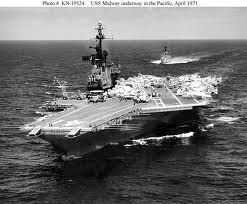The new Ford class carrier construction cost is up around $12B-$13B already and will probably finish at $14B or so and I believe that’s without including government supplied equipment as we’ve discussed in a previous post. New carrier construction schedules have already been lengthened out to a seven year cycle. The simple math of acquisition tells us that the carrier fleet will continue to decline to around 8-9 active carriers in the moderately near future. The sad fact is that carriers are pricing themselves out of existence in the face of the new budget reality.
In addition to the cost factor, there has been a vocal faction arguing for small carriers since the carrier was first introduced. As a reminder, the USS Wasp, sunk early in WWII, was an attempt to develop a small carrier. The Navy has done numerous studies on this issue and the conclusion has always been that larger carriers were the most efficient and cost effective form. This conclusion has not, and will not change.
So, why is ComNavOps looking at this issue? Because, while the conclusion that larger carriers are more effective has not changed, the affordability has. As I stated, carriers are pricing themselves out of existence. It doesn’t matter how powerful, flexible, and effective the large carrier is, if you can’t afford it, you can’t build it. What do we do then – continue to build supercarriers at a slower and slower rate until we eventually only have a single superhugemassivecarrier? It may be time to re-examine the small carrier question just because of cost. The small carrier may not be the best way to conduct carrier operations but it may be the only way we can afford to build and operate carriers, period. The cost efficiency of the small carrier may be poorer than a supercarrier but the total cost is less. We’re fast approaching the point at which total cost is the driving factor rather than cost efficiency.
The Navy may already be recognizing this problem. The new America
 |
| Midway - Small Carrier Option? |
So, the LHA-6 class could provide a small carrier with some very limited capability. Is there any other option? Yes, the old Midway class in its modernized form offers a possible alternative.
The Midway was around 900 ft long versus the 1050 ft of a Nimitz and around 67,000 tons loaded versus the 95,000 tons of a Nimitz. We see, then, that the Midway is around two thirds the displacement of a Nimitz.
What about the air wings? Weren’t the Midways limited compared to the Nimitz? No, not compared to today’s Nimitz. The Midway operated an air wing of around 65 aircraft consisting of three squadrons of Hornets and two squadrons of Intruders along with Hawkeyes, Prowlers, and helos. Today’s Nimitz air wings consist of around 65 aircraft consisting of four squadrons of Hornets plus Hawkeyes, Prowlers/Growlers, and helos. Virtually identical except that the Midway air wing actually had more combat aircraft!
So, a smaller carrier of 2/3 the displacement of a Nimitz (even less compared to a Ford) has been proven to be able to operate the same air wing as current carriers.
Any light bulbs going off yet?
What would a Midway size carrier cost today? Who knows, but we know the Fords will cost around $12B each. The America class LHA is around 850 ft long and 45,000 tons displacement and costs around $4B. A reasonable extrapolation, then, would be for a cost of $6B for a Midway size carrier. In other words, we could build two Midways for each Ford and still operate the same size air wings. In this time of constrained budgets, that’s got to at least be worth some serious consideration.
Now, before some of you start pounding out your replies and telling me about sortie rates and whatever else, note that I’m not claiming that a Midway size carrier would be better than (or even equal to) a Ford. I’m saying that we’re fast approaching the point where our choice is not going to be between big carriers and smaller carriers but between smaller carriers and no carriers. I guess I’d rather have smaller carriers than no carriers. Sadly, the Navy is riding the big carrier option right down to zero carriers.



